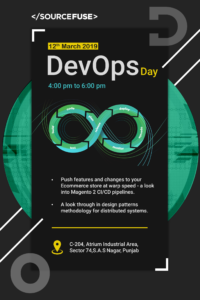DevOps, what is it?
DevOps is the accumulation of people, tools, and processes. Meant to improve upon legacy software development practices through increased speed and flexibility between the business and the development side of IT. Eliminating rigid operations and distributed ownership.
According to Amazon Web Services, DevOps is the combination of cultural philosophies, practices, and tools that increases an organization’s ability to deliver applications and services at high velocity.
According to our own Senior DevOps Engineer here at SourceFuse, Susovan Panja DevOps is defined as:
DevOps for me is a culture, its a mindset, its set of practices, its collection of tools that enables an organization to deliver applications or services at a very high velocity. It also enables them to improve and evolve their products at a faster pace.
In a DevOps environment, teams can share code bases, benefit from continuous integration, and take advantage of automatic deploys to expose problems early on in the development process.
All to improve the deployment frequency, allowing faster time to market, a lower failure rate of new releases, shortened lead time between fixes, and faster disaster recovery.
High-performing DevOps organizations see:
- 200x more frequent deploys
- 24x faster recovery times
- 3x lower change failure rates
“According to a recent stat, 74% of organizations have already implemented DevOps tools for cloud and the rest 26% are still deciding on the process.”
Where did DevOps come from?
In traditional software building methods and processes, the Developer codes, and the IT operations team deploys the code to servers. In this traditional approach, both Development and IT operations have little to no idea what the other was up to. Making debugging the code, even more difficult than writing it in the first place!
DevOps History & Origins
In 2009, two great mindsets came together. Patrick Debois from Belgium and Andrew “Clay” Shafer from the US, met and coined the term DevOps. They created a cross-disciplinary community that uses tools to make software testing and deployment faster, reliable and possibly free of required human interaction.
What are some common DevOps challenges?
To answer this question, we asked the DevOps team here at SourceFuse and they laid out three specific points.
- Mentality – Employees and department heads all must adopt a DevOps mindset.
- Complacency – People are comfortable with their current process and role and not ready to embrace change.
- Need for results – Our team has seen the pressure first-hand within organizations and their need for immediate tangible results. A DevOps transition does take time, and can not happen overnight.
DevOps is a culture, not a role one person can fill. The whole company needs to adopt a DevOps mindset for it to be effective.
Requiring backing from senior leadership, involvement from department directors, and complete buy-in from everyone with a stake in the final product, not just development and operations departments.
Why should you adopt a DevOps model?
DevOps can provide a boost in productivity, performance, and collaboration. Professionals who have adopted a DevOps model tend to be fanatical. These ambassadors also tend to be consistent, using the below three points to routinely win over others.
- Stability: High-performing DevOps organizations spend 22% less time on unplanned work and rework. As a result, they are able to spend 29% more time on new work, such as new features or code.
- Security: DevOps organizations spent 50% less time remediating security issues than low performers.
- Speed: Gain the ability to deploy multiple times per day, on demand. Compared to traditional models who struggle to keep up with deployments on weekly cadence.
One of our DevOps fanatics Rajat Chawla, believes the main benefits of DevOps are:
“High-velocity releases and an infrastructure-as-code culture.”
High-velocity means you are constantly improving and evolving your application. Evolving and improving products at a faster pace than organizations using traditional software development and infrastructure management processes. DevOps provides confidence and quality to this rapid process. Helping your organization catch errors or issues even before they are merged into the source control.
Infrastructure-as-code culture enables an organization to maintain the same infrastructure across environments. Which means when you are creating a new environment, it will be the same as your existing ones and it does not have to be done manually. Because manually configuring, provisioning and changing the infrastructure components (VM, Networks, Firewalls, Load Balancer) can have associated errors and risks, such as:
- Changes can become difficult to track
- Versioning and consistency is up to human administration
- Rollbacks can become troublesome
Is DevOps a fad?
It’s been a decade since Patrick and Clay had their sit down and coined the phrase DevOps. In today’s fast evolving world of software and business technology, 10 years is a lifetime! So, in case time and stability are not enough to convince you that DevOps is here to stay perhaps the fact that DevOps is the first process to successfully integrate business users, developers, test engineers, security engineers, and system administrators into a single workflow focused on meeting customer requirements will help you validate the practice.
How can I learn more about DevOps?
We understand that one blog is not enough to fully understand the potential of DevOps. So, we are hosting our first DevOps Day of 2019 in our Mohali office this Tuesday.
The event is open to everyone and free of charge, all you have to do is RSVP here.
